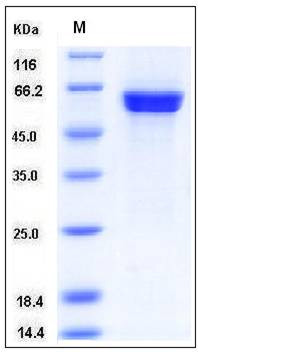Human CAMK1D / CKLiK Protein (GST Tag)
CaM-K1,CaMKID,CKLiK
- 100ug (NPP1951) Please inquiry
| Catalog Number | P10728-H09B |
|---|---|
| Organism Species | Human |
| Host | Baculovirus-Insect Cells |
| Synonyms | CaM-K1,CaMKID,CKLiK |
| Molecular Weight | The recombinant human CAMK1D/GST chimera consists of 610 amino acids and predicts a molecular mass of 69 kDa. It migrates as an approximately 60 kDa band in SDS-PAGE under reducing conditions. |
| predicted N | Met |
| SDS-PAGE |  |
| Purity | > 96 % as determined by SDS-PAGE |
| Protein Construction | A DNA sequence encoding the human CAMK1D (NP_705718.1) (Met 1-Lys 385) was fused with the GST tag at the N-terminus. |
| Bio-activity | The specific activity was determined to be 70 nmol/min/mg using Autocamtide-2 synthetic peptide (KKALRRQETVDAL-amide) as substrate (see Activity Assay Protocol) |
| Research Area | Signaling |Signal Transduction |Protein Kinase |Intracellular Kinase |Ca2+/Calmodulin-Dependent Protein Kinase (CaM Kinase) |
| Formulation | Supplied as sterile 50mM Tris, 100mM NaCl, 0.5mM Reduced Glutathione, pH 8.0 1. Normally 5 % - 8 % trehalose, mannitol and 0.01% Tween80 are added as protectants before lyophilization. Specific concentrations are included in the hardcopy of COA. |
| Background | Calcium/calmodulin-dependent protein kinase or CaM kinases are serine/threonine-specific protein kinases that are primarily regulated by the Calcium/calmodulin complex. These kinases show a memory effect on activation. CaM kinases activity can outlast the intracellular calcium transient that is needed to activate it. In neurons, this property is important for the induction of synaptic plasticity. Pharmacological inhibition of CaM kinases II blocks the induction of long-term potentiation. Upon activation, CaM kinases II phosphorylates postsynaptic glutamate receptors and changes the electrical properties of the synapse. |
| Reference |
